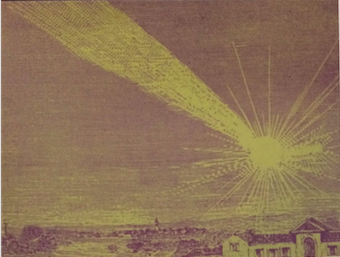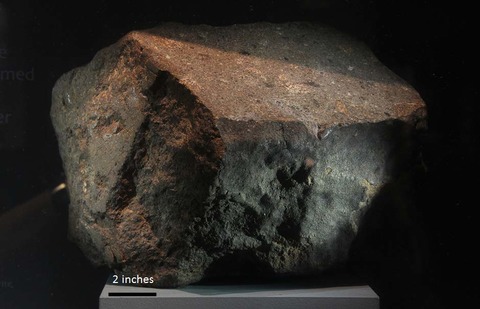The Weston Meteorite
 Nathan Wheeler stood outside his house. It was an early winter morning in 1807. The sun hadn’t come up yet. Suddenly, he saw a bright flash of light. He heard three loud bangs. He heard rumbling that sounded like a cannon ball rolling over a floor. What could it be?
Nathan Wheeler stood outside his house. It was an early winter morning in 1807. The sun hadn’t come up yet. Suddenly, he saw a bright flash of light. He heard three loud bangs. He heard rumbling that sounded like a cannon ball rolling over a floor. What could it be?
Wheeler was treasurer, town clerk, and Justice of the Peace for the town of Weston. Weston was a quiet farming town. But on December 14, 1807, the day started with a bang.
Merwin Burr was up early, too. He saw something crash near his home in the northeastern corner of town. After the sun rose he found a gray stone the size of a goose egg. It was still warm to the touch.
Five miles south of Burr’s farm, William Prince was still in bed. He awoke to a flash of light. He saw a patch of smoking ground. He thought lightning had struck. Later he found a 35-pound rock, sunk two feet in the ground.
A meteorite had landed in Weston! A meteorite is a space rock that burns in the atmosphere before reaching earth. The three loud bangs were the meteorite exploding. Parts of it were found scattered across Weston. Pieces were found 10 miles apart. Some of them landed in Trumbull. This was the first meteorite recorded in the United States.

Piece of the Weston meteorite, 1807. Peabody Museum of Natural History
Two professors from Yale College went to investigate. They interviewed witnesses. They collected pieces of it to study. Newspapers reported that people in New York, Vermont, and Massachusetts saw the ball of fire streak across the sky. People heard it 50 miles away. Professor Benjamin Silliman wrote a detailed report for the scientific community. His report was published many times in the coming years.
A big piece landed on Elijah Seeley’s farm in Trumbull. But it hit a stone and shattered. It left a giant hole, though, five feet long and three feet deep. Silliman estimated that the piece may have weighed nearly 200 pounds. It scared Seeley’s cows so much they jumped into the next field.
The discovery was of great interest. Not much was known about meteorites. President Thomas Jefferson was not convinced that it came from space.
Silliman gained fame and fortune for his discovery. He lectured all over the northeast. He built a special place in his carriage to carry the meteorite specimens.
Today, fragments of the meteorite are on display in Yale’s Peabody Museum. The Weston meteorite was estimated to weigh about 350 pounds. However, Yale’s meteorite collection has only accounted for 50 pounds of it.
This story is based on “Connecticut Catches a Falling Star” by Marshall Berdan, Connecticut Explored, Winter 2007-2008.


 Nathan Wheeler stood outside his house. It was an early winter morning in 1807. The sun hadn’t come up yet. Suddenly, he saw a bright flash of light. He heard three loud bangs. He heard rumbling that sounded like a cannon ball rolling over a floor. What could it be?
Nathan Wheeler stood outside his house. It was an early winter morning in 1807. The sun hadn’t come up yet. Suddenly, he saw a bright flash of light. He heard three loud bangs. He heard rumbling that sounded like a cannon ball rolling over a floor. What could it be?